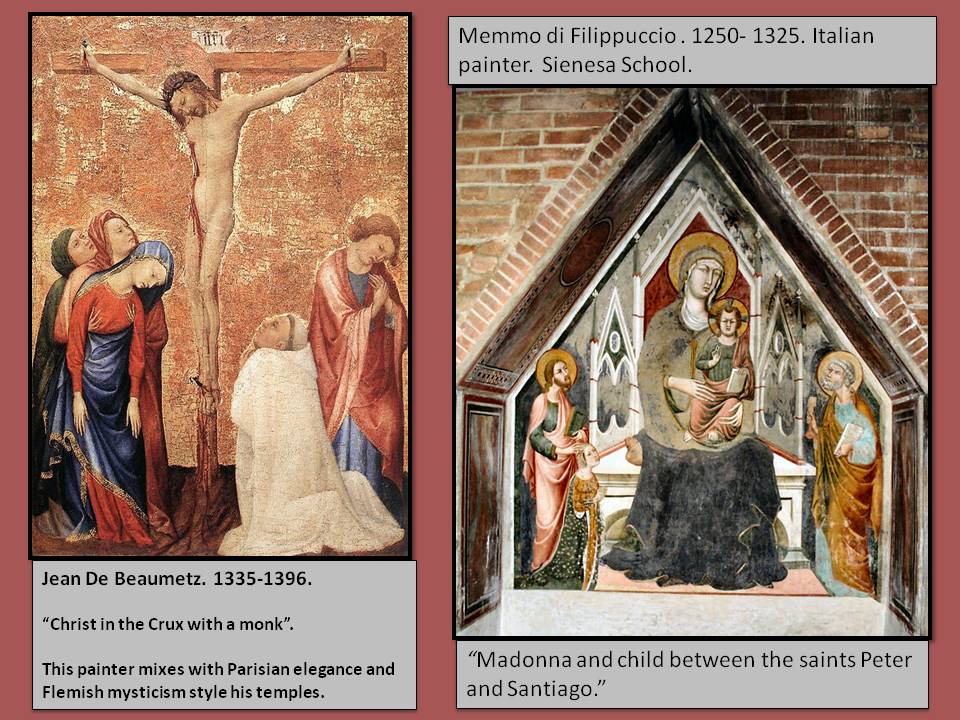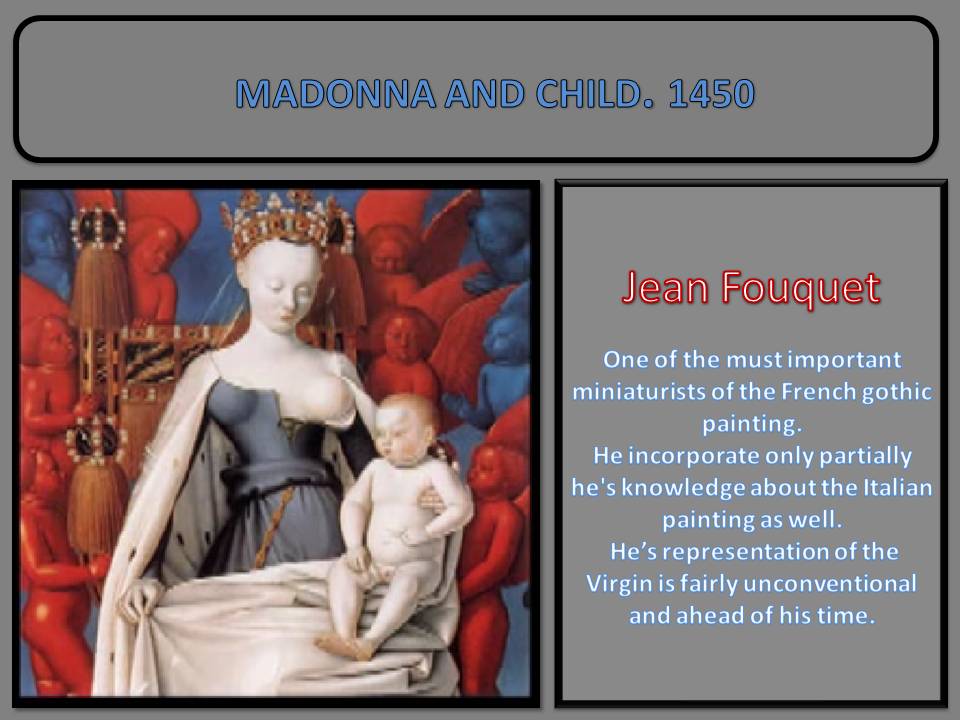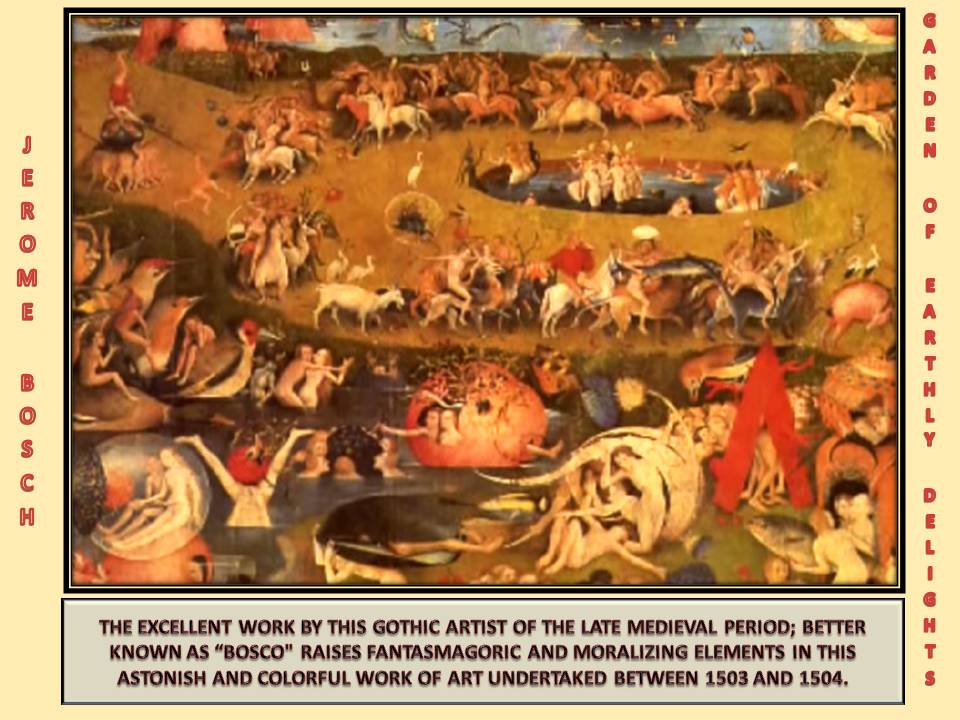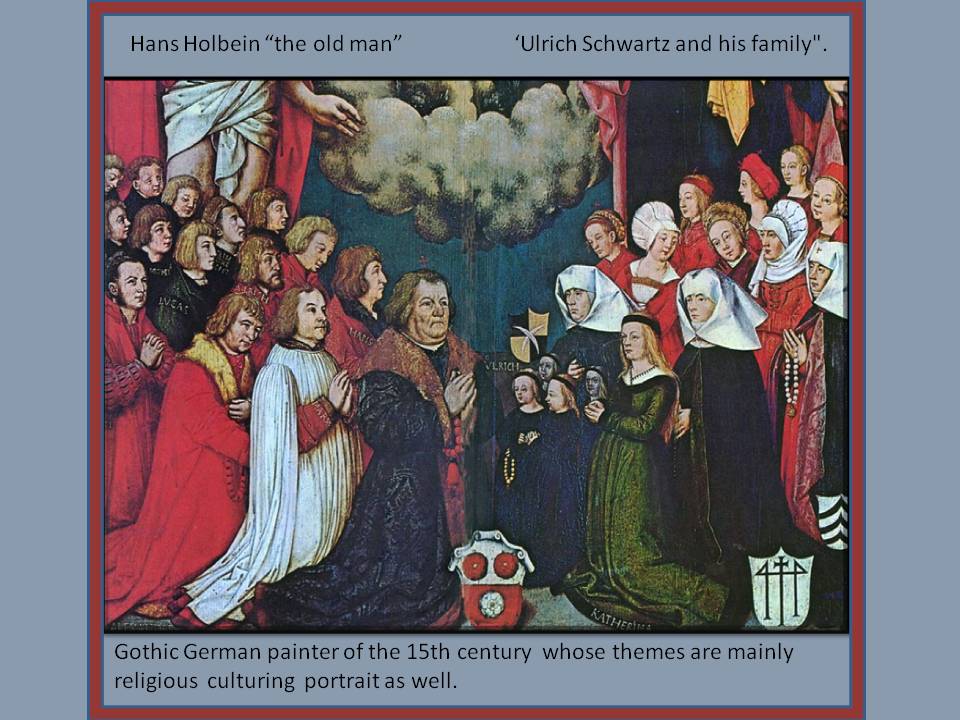GOTHIC ART PAINTING
As soon as the Gothic style acquire some popularity and a large number of churches, cathedrals and monasteries were built in different European capitals, the traditional fresco painting was declining as to be the medium of choice to decorate the walls, since these had been in that period largely replaced by huge multicolored stained glass windows. Through them light come from the outside showing beautiful and hypnotic paintings made by craftsmen glassmakers whose mastery during the Gothic period reached notorious splendor.
It is not possible in fact to talk about the Gothic period without mentioning these impressive stained glass windows paints, whose effect on viewers is of undoubted dramatic effect. Among the most notorious stand out those of the Cathedral of Chartres, the cathedrals of Bourges, Tours, Bayeux, the Cathedral of León and the Santa Chapel in Paris. Not forgetting the Cologne Cathedral in Germany and the Amiens cathedral in France. The magnificent windows of the revival period in England are as well wordiest of mention.
The sole exception in joining this trend was Italy where the stained glass windows did not reach the importance that those had in the rest of Europe during the early and middle gothic. In this country painting at fresco continued having importance in the decoration of the cathedrals and monasteries as well as it was also a support structure that contribute to develop the Sienesa School where some painters highlighted; among them Giotto .
But the traditional painting had to reformat the basis upon which they will represent religious, mythological, and everyday life issues such as for example the portrait of the bourgeoisie. Painting on wood and illuminated manuscripts became more active part in the plastic media in the 14th century.
The illuminated manuscripts in the Gothic period continued the custom to combine the colorful paintings with texts to contribute to its understanding and better illustrate the stories narrated. Although in the majority of those manuscripts these paintings are anonymous others have some discrete identification of the Illustrator who made them.
There are still many manuscripts commissioned specific by Maecenas and others important personalities that are preserves in perfect conditions showing all the splendor and exquisite details that those master illustrators developed. They had survived thanks to have been carefully kept in private collections away from public view or inadequate handling.
It was not until nearly thirty years has pass since the Gothic architecture was already in the preference of the artists that happens an imperceptible transition in the representations of miniature paintings in manuscripts between the Romanesque period and the one made in the Gothic period. The religious characters start to be represented more natural and realistic in reference to human figures, with details on the representation of their anatomy, about of which those artist previously lack knowledge. The more important miniaturists were Jean Pucelle, Jacquemart of Hesdin and the Limbourg brothers.
Diptychs and triptychs with religious theme over wood were commissioned by the Church hierarchy to decorate altars, pulpits and different rooms inside of these religious buildings. But the themes represented on wooden boards in that period are not only religious themes because some portraits of bourgeois and wealthy personalities are done as well.
Main Gothic painters’s and their works
Among the artists who stand out in the Gothic period from very young by his great talent, ingenuity and spirit of innovation is Giotto Di Bondone. Giotto came to be considered one of the most important teachers of the painting of his time, master of other painters, whose style has a keen interest in the pictorial narrative and the spirituality. Human emotions are predominant in his work intensified by the Franciscan influence. He was followed and imitated by many others, among them Andrea Orcagna, Taddeo Gaddi and the painter Tommaso di Stefano, known by its pseudonym “Giottino”.
Giotto develops in frescos the ‘pictorial space’ an area of three-dimensional feeling that extends in depth behind the painted surface. His most important work was the decoration of the chapel for the Scrovegni family in Padua. Those frescoes made on the walls and vault consist of numerous boxes or “Windows” and are dedicated to narrate biblical themes in so innovative, realistic and emotive way that those paintings constitute a true unparallel art work.
Contemporary with the Giotto is the works of Duccio Di Buoninsegna. In his most important work “the Maesta” completed in 1311 stands out with amazing use of color. This work, which suffered vicissitudes since its realization shows a complex staged composition but its message is simple to understand thanks to the expressions and gestures of the characters; some of which are looking directly to the Viewer as it is the case of the Virgin Mary. She is represented in a larger size with a majestic and serene pose making the viewer participate in the scene.
The Limbourg brothers that we mention before among the illustrators of manuscripts managed very well the color in their miniatures. Those paints had a brightness and intensity uncommon for that period. Their magnificent paintings are eloquent of the attention to detail and laborious work applied to them in a conscious effort to represent their surrounding reality. They were also the pictorial decorators of larger size paintings in castles and churches. Their knowledge of various craft specialties learned from youth formed their style and has a significant relevance in the development of their natural talent. Their technique was very advanced for its time achieving to represent the perspective and the tridimensional space with a precision that did not have other painters of the period.
Their most prominent work “The rich hours of Jean de Berry” a very good example of their pictorial work is perhaps the most famous manuscript ever made. They developed unconventional subjects some of which were made to please their patron and dearest Maecenas (a rich patron of the arts) the Duke of Berry. Their dead that came unfortunately very soon; in the pick of their development as artist, crushed for us the possibility to enjoy now even more examples of their exquisite work.
New painting technique’s in the Gothic period.
New painting techniques as it is the case in the use of oil for painting over a board allow magnificent realizations where the characters and the scenes in which they are represented show a great naturalness and are also portrayed with details and interest in represent them with realism. This contributed to bring viewers more effectively to the human emotions which are represented such as pain, humility, religious devotion, tragedy or fervent devotional joy. The oil painting allows retouching and application by layers so the final result is polished. this technique known as Impasto where the material is applied in thick layers to wooden panels or canvas; allow craft strokes to be visible and dimensional aspects enhanced. The resulting textured effect of impasto adds a lifelike dynamic quality to imagery.
These painters not yet dominate the perspective. Their works still do not possess sense of depth. However the way they use color and definition of the figure’s lines supplemented somewhat that lack of knowledge as to how to represent depth and three-dimensionality.
The painter Jan Van Eyck stood out for his portraits of the bourgeoisie of the time and give to his character’s life through the detail of faces, clothes and hidden messages in the representation of objects or clues in the scenes that convey a great conceptual value. This style applies framework bases that over time the Renaissance painters echoed. His outstanding work was a portrait of a married coupled of bourgeois known as “The Arnolfini portrait “in with the painter himself appear in the mirror besides other wedding guest. Jan van Eyck knew how to mix paints using an innovative combination of oil and egg to produce this masterpiece in the final years of the middle Ages.
Rogier Van Der Weyden. This Flemish painter work corresponds with the “primitive” movement style. He performed his most outstanding work around the year 1435. “The descent” painted with oil on wood correspond with the late Gothic. He performed less intellectualized and simpler models to be better understood by viewers and therefore his style reached widespread. He intensifies the emotional representation of its characters and achieves a compositional rhythm in the scenes. The function of these paintings is taken into account. This work was made for a triptych but remains only the central panel nevertheless it shows the effort to organize the composition based on where it would be located. That is the case in Roger Van Der Wayden work’s in “The Last Judment Polyptych” (1445-1450).
Jean Fouquet an excellent miniaturist artist representant of the French painting in the Gothic period made its little traditional “Madonna and child” in 1450 that breaks with the old canons of representation of the divine Madonna. The Virgin represented by Jan Fouquet is showing a bare-breasted female and a contemporary attire of the time. This Madonna has a face that departs from the common appearance conferred to the Virgin traditionally and which could well be the face of a coetaneous bourgeois woman as it was rumored in fact by scholars. The deep red color that will represent the figures surrounding the mother and child are also fairly unconventional that will emphasize subtly elements that differentiate the good from the evil.
Geronimo Bosch is among the great painters we cannot fail to mention. His unconventional and unique style delivers wide range of skills that opens the thinking of many of his coetaneous. His mainly and must famous work was the almost dream-like representation of “The garden of earthly delights”. Bosch brings to us an apparent mad composition that stuns the spectators with the complexity of its arrangement. Hundreds of orgy carefree characters in this paint are illustrated in a spooky vision of this biblical passage. Moralizing elements converge in an obvious bizarre composition that shows vices, evil, perversity, betrayal, lust and gluttony among other sins portraying the outrageous behavior of a corrupted humanity.
The symbolism of the characters, the representation of their actions and the presence of numerous animals in various micro- scenarios within the composition contribute to the perception of it as though the viewers are recalling a very unusual but colorful nightmare. The use of color supports the intention of establishing several planes in the composition. The gestures of the characters; most of them naked, emphasize the drama and intention of the actions.
Jean De Beaumetz 1335-1396, among other Gothic painters make efforts to represent certain deepness in his works and was trough the use of the color and the position of the characters in the scene that he give us his best version of a much natural reality. He was a Franco-Flemish painter belonging to the international style. This painter mixes with Parisian elegance and flamenco mysticism style his work. In his paint “Christ on the cross with a monk” represents the dramatic scene in which Christ is crucified and where the characters broken down by pain transmitted with the gestures of their hands the paroxysm of the scene in a fairly flat and simple background. The colors of their clothes reveal the identity of the characters represented with which the viewer can identifies almost immediately.

Memmo di Filippuccio 1250-1325 also from the Sienesa School. Developed fresco painting where the use of color highlights the emotions of the characters. An example of his work is the fresco ‘ Madonna and child between Saints Pedro and Santiago”. Others painters from the Tuscan school are also distinguished, particularly the work of the artist Giunta Pisano in the 13th Century deserve to be mentioned.
In Germany the Gothic painters left us beautiful examples of their works in which new techniques were applied in painting and although the styles that were expressed were diverse the predominant use of color was a constant that emphasized the elements that they want to highlight. As a prominent example can be mentioned the painter Hans Holbein “the old” gothic painter of the 15th century, whose theme is mainly religious but he also made portraits. One of these examples is the portrait of ‘Ulrich Schwartz and his family”.
Although the Gothic painting came to have a wide range of styles, schools, trends and different palettes there is no doubt that those painter’s reflect their surroundings and the particular characteristics of the regions in which they lived or visited. In each European country they achieve to express their style according to their artistic heritage, local costumes, religious believe, social circumstances and their individual talent that in that period started to be recognized as such reaching the artist social importance and consideration among this medieval but also bourgeois society.
The constant introduction of new techniques, pigments, and materials contribute to the diversity and outstanding art pieces created in the gothic period painting. They artist always were looking to found ways to represent perspective and three dimensionality but the right way to do this will not be a reality until the Renaissance period.













